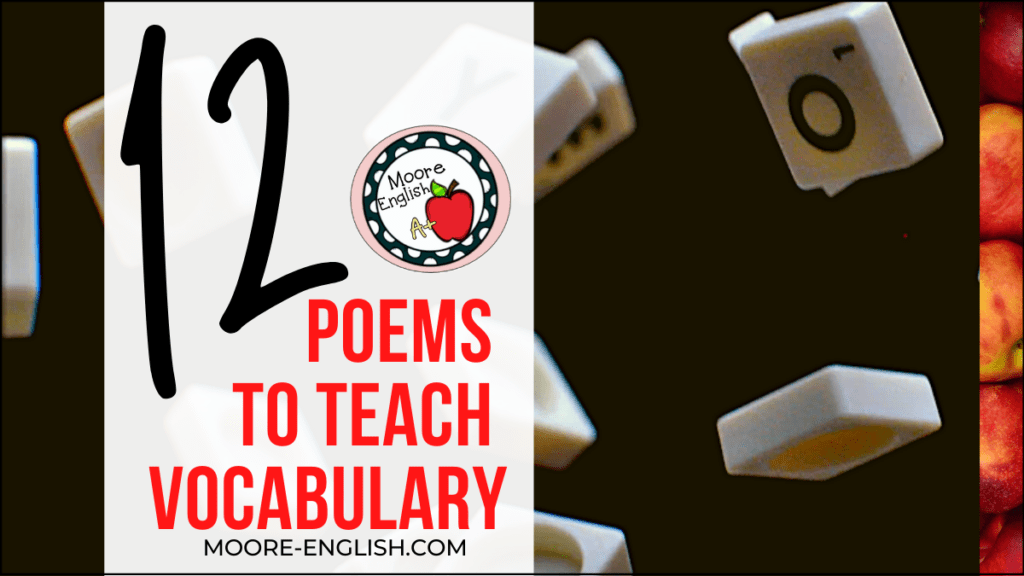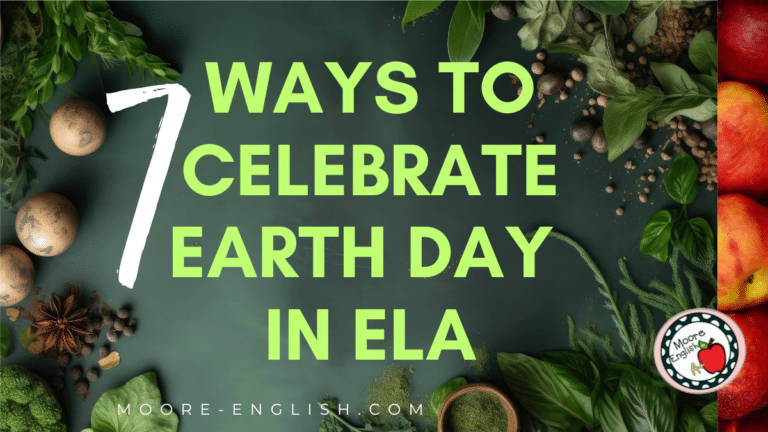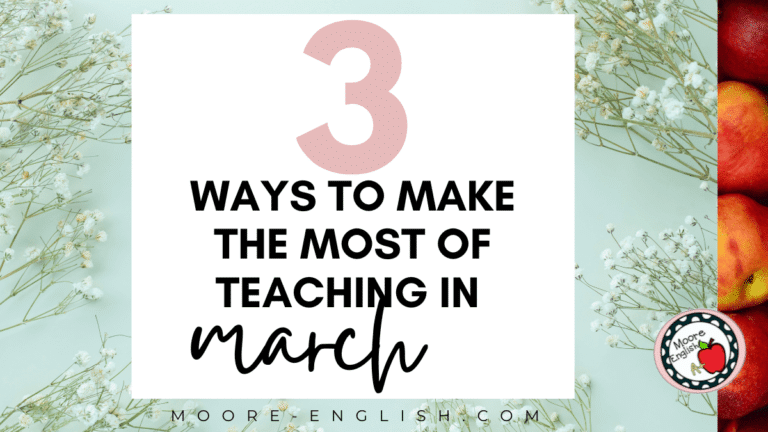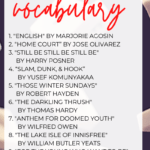We tend to think of CCSS.ELA-Literacy.RL.9-10.4 and 11-12.4 in terms of context clues, but this standard lends itself to so much more in terms of word work, analyzing word choice, connotation, and figurative language.
To help students focus on these skills, I’ve put together this collection of poems. Some of the poems truly lend themselves to context clues work while others are stronger candidates for working on connotative meaning and analyzing word choice.
This post this post may contain affiliate links. Please read the Terms of Use.
9-10 Poems for Teaching Vocabulary
At the 9-10 level, I looked for poems that are more approachable in form and topic while still providing students with opportunities to practicing analyzing language.
- Wilfred Owen’s “Anthem for Doomed Youth” is a visceral, powerful, and challenging poem. His words continue to resonate across the generations. This is also a poem where the cumulative impact of Owen’s word choices underlines his main idea in a compelling and tragic manner. Read it here.
- “On Being Brought from Africa to America” by Phillis Wheatley is one of the earliest pieces of American poetry. While this is a short poem, it’s a piece where historical context and tone complicate word choice. Wheatley also makes frequent allusions that require students to analyze in order to interpret her meaning. Read it here.
- “The Darkling Thrush” by Thomas Hardy is a classic, poignant poem. His words are lovely, endearing, and visionary. From a vocabulary standpoint, this is a good poem for practicing context-clues strategies. In addition, this poem is a great tool for analyzing setting, tone, and character. Read it here.
- Claude McKay’s “Summer Morn in New Hampshire” is a perfect poem for analyzing word choice, especially since McKay made critical revisions to the poem in 1920 and 1922. Evaluating the different word choices made in the revision opens a door into a conversation about connotation. In addition, this poem helps students analyze text structure, point of view, and main idea. Read both versions here.
High-Interest Titles
- “Slam, Dunk, & Hook” by Yusef Komunyakaa is a deceptive poem. At first, the subject of basketball engages my students. But this isn’t really a poem about basketball, and once students realize it’s a poem about racism and prejudice, subjects they are so invested in right now, they remain hooked. This is also a poem where allusion and connotation play a significant role in how readers understand the language choices. Read it here.
- “Home Court” by Jose Olivarez, like “Slam, Dunk, & Hook,” engages students because they recognize basketball. By the time students realize this is a poem about grief, they’re too invested to pull back. Reading this poem alongside “Slam, Dunk, & Hook” or even alongside Kyle Korver’s article “Privileged” is a good way to practice synthesis skills in addition to vocabulary work. (All 3 of these basketball-themed resources are included in my Basketball Literature Bundle.) Read it here.
Find all 6 9-10 poems in the 9-10 Poetry to Teach Vocabulary Bundle, which features all of the poems and lesson plans linked here. This bundle is ideal for freshman and sophomore ELA teachers. Ultimately, it includes 45 pages and 130 questions! To make this even easier, I have also put together a free pacing guide for these poems!
11-12 Poems for Teaching Vocabulary
For the 11-12 students I’ve selected poems that make more challenging word choices, have more ambiguous meanings, use tones that complicate word meaning, and/or have more elaborate structural elements. In other words, the 11-12 poems require a higher level of analytical interpretation.
- Robert Hayden’s “Those Winter Sundays” is a poem that looms large in American literature. On the surface, the poem is relatively simple, but there is tremendous complexity underneath the language. More interestingly, this is also a poem where word choice creates mood. Read it here.
- “Spring and Fall: To a Young Child” by Gerard Manley Hopkins is my favorite poem ever. (I also adore “God’s Grandeur,” which is a better poem for teaching text structure.) In addition, Hopkins’ use of sprung rhythm and enjambed lines complicates his vocabulary. Furthermore, Hopkins’ talent for coining words makes this poem ideal for practicing vocabulary skills. Read it here.
- “The Lake Isle of Innisfree ” by William Butler Yeats, one of the great Irish voices of Modernism. His words are vivid and visual, making his poems great tools for helping students work toward vocabulary standards (“The Second Coming” is a central part of my unit plan for Things Fall Apart). In particular, this poem is a good example of vocabulary creating imagery. Read it here.
Unique or Surprising Recommendations
- “English” by Marjorie Agosin, translated by Monica Bruno, is a poem that both makes interesting vocabulary choices while also commenting on language itself. Agosin also moves between English and Spanish, making allusions and word choices that comment on the development of language, the colonization of language, and how meaning evolves over time. This is kind of a tricky text to find, but I found the poem in the textbook What’s Language Got to Do with It? I also found this .pdf online.
- “For the young who want to be” by Marge Piercy makes seemingly simple word choices like “talent,” “work,” and “genius.” But the speaker’s tone complicates and changes the meaning of each of these words. Furthermore, the poem’s central conflict comes from differing definitions. This is an excellent poem for analyzing how tone affects meaning and main idea. Read it here.
Find all the 11-12 poems in the 11-12 Poetry to Teach Vocabulary Bundle, which features all of the poems and lesson plans linked here. This bundle is ideal for junior and senior ELA teachers. It includes 40 pages and 150 questions! To make this even easier, I have also put together a free pacing guide for these poems!
More Poetry Resources
Finding and developing lessons for unique, insightful, and student-friendly poems is one of my missions! Over the years, I’ve developed several collections of poems that fit specific classroom and student needs. Check them out here!
- 9-12 Main Idea Poetry Bundle and blog post
- Story Elements Poetry Bundle and blog post
- 9-12 Poetry Inference Bundle and blog post
- 9-12 Poems to Teach Text Structure and blog post
- Poems for Teaching Characterization Bundle and blog post
Save more with the 9-12 Poetry to Teach Vocabulary Bundle, which features all of the poems and lesson plans linked here. All together, you get almost 85 pages and 280 poetry questions!


Photo by Piotr Łaskawski on Unsplash
















